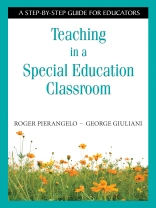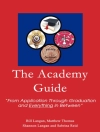‘Probably one of the best books I′ve read that guides special educators from the beginning of the year to the end.’
—Nicole Chiarello-Guyon, Special Education Teacher
Westerly School Department, RI
‘The tips and strategies provided will help any teacher grow professionally.’
—Teri Fechter, Specific Learning Disabilities Teacher
Franklin Elementary School, Appleton, WI
Tips and strategies for the new and experienced special education teacher!
Designed for professionals working in a resource room, self-contained special class, or inclusive setting, this step-by-step guide helps new teachers in special education get their careers off to a positive start and offers experienced teachers supportive information to help improve classroom practice.
Special education experts Roger Pierangelo and George Giuliani review all aspects of special education teaching, from how to get to know your students before school starts to writing end-of-the-year reports. Aligned with the reauthorization of IDEA 2004, this guidebook provides practical guidelines for appropriate classroom design, includes a complete glossary, and examines critical issues such as:
- Gathering information on students′ educational history, medical background, and Individual Educational Programs (IEPs)
- Meeting with parents, aides, mainstream teachers, and service providers
- Addressing and evaluating factors that affect learners′ performance and adapting the curriculum
- Managing a classroom of students with specific disabilities and applying instructional interventions
- Understanding grading options
Teaching in a Special Education Classroom offers straightforward advice to make the school year more productive for you and your students.
Tabla de materias
Preface
Acknowledgments
About the Authors
Step I. What to Do Before the Start of School
Getting to Know Your Students
Step II. Designing and Setting Up Your Classroom
Classroom Design
Setting Up Your Classroom
Evaluating Existing Materials
Step III. Meeting With Parents and Staff Members
Communicating With Parents
Meeting With Your Assistant Teacher or Aide
Communicating With Related Service Providers
Communicating With Your Regular Education Teachers
Communicating With the Mainstreamed Class and Teachers
Step IV. Factors Affecting Curriculum Performance for Students With Special Needs
Introduction
Factors Affecting Curriculum for Children With Special Needs
Step V. Adapting the Curriculum for Students With Special Needs
What Are Curriculum Adaptations?
Examples of Curriculum Adaptation
Ways to Adapt the Curriculum
Adapting Response Mode
Step VI. Classroom Management of Children With Specific Disabilities
Students With Learning Disabilities
Students With Mental Retardation
Students With Emotional Disabilities
Students With Attention Deficit/Hyperactive Disorder
Step VII. Applying Instructional Interventions for Specific Behaviors Exhibited in the Classroom by Students With Emotional and/or Behavioral Disorders
Instructional Interventions for Attendance Problems
Instructional Interventions for Difficulty With Transitions
Instructional Interventions for Disrespect to Teachers
Instructional Interventions for Classroom Disruption
Instructional Interventions for Failure to Accept Responsibility for Own Behavior and/or Consequences for Misbehavior
Instructional Interventions for Interpersonal Relationships With Peers
Instructional Interventions for Out-of-Control Behaviors
Instructional Interventions for Passive Resistance
Instructional Interventions for Not Respecting Property or Personal Space of Others
Instructional Interventions for Verbal Aggression
Instructional Interventions for Verbal Outbursts
Step VIII. Understanding Grading Options for Students With Special Needs
Grading Approaches
Reporting to Parents
Step IX. Developing Educational Treatment Plans for Your Students
Step X. End-of-School-Year Responsibilities
Triennial Evaluation Reports
Annual Review Meetings
Declassification Consideration and Procedures
Extended-School-Year Services
End-of-the-Year Reports
References
Glossary
Index
Sobre el autor
George Giuliani is an assistant professor at Hofstra University′s School of Education and Allied Health and Human Services, in the Department of Counseling, Research, Special Education, and Rehabilitation. He is the executive director of the National Association of Special Education Professionals, president of the National Association of Parents with Children in Special Education (NAPCSE), vice-president of the National Association of Special Education Teachers, and an educational consultant for various school districts. He has provided numerous workshops for parents and teachers on a variety of special education and psychological topics.Giuliani earned Board Certification as a Diplomate Fellow in Child and Adolescent Psychology and Forensic Psychology from the International College of Professional Psychology. Giuliani is also a New York State licensed psychologist, certified school psychologist, and has an extensive private practice focusing on children with special needs. He is a member of the American Psychological Association, New York State Psychological Association, the National Association of School Psychologists, Suffolk County Psychological Association, Psi Chi, American Association of University Professors, and the Council for Exceptional Children. Giuliani earned his BA from the College of the Holy Cross, MS from St. John′s University, JD from City University Law School, and Psy D from Rutgers University, The Graduate School of Applied and Professional Psychology.Giuliani is the coauthor of numerous books, including The Big Book of Special Education Resources and The Step-by-Step Book Series for Special Educators.












